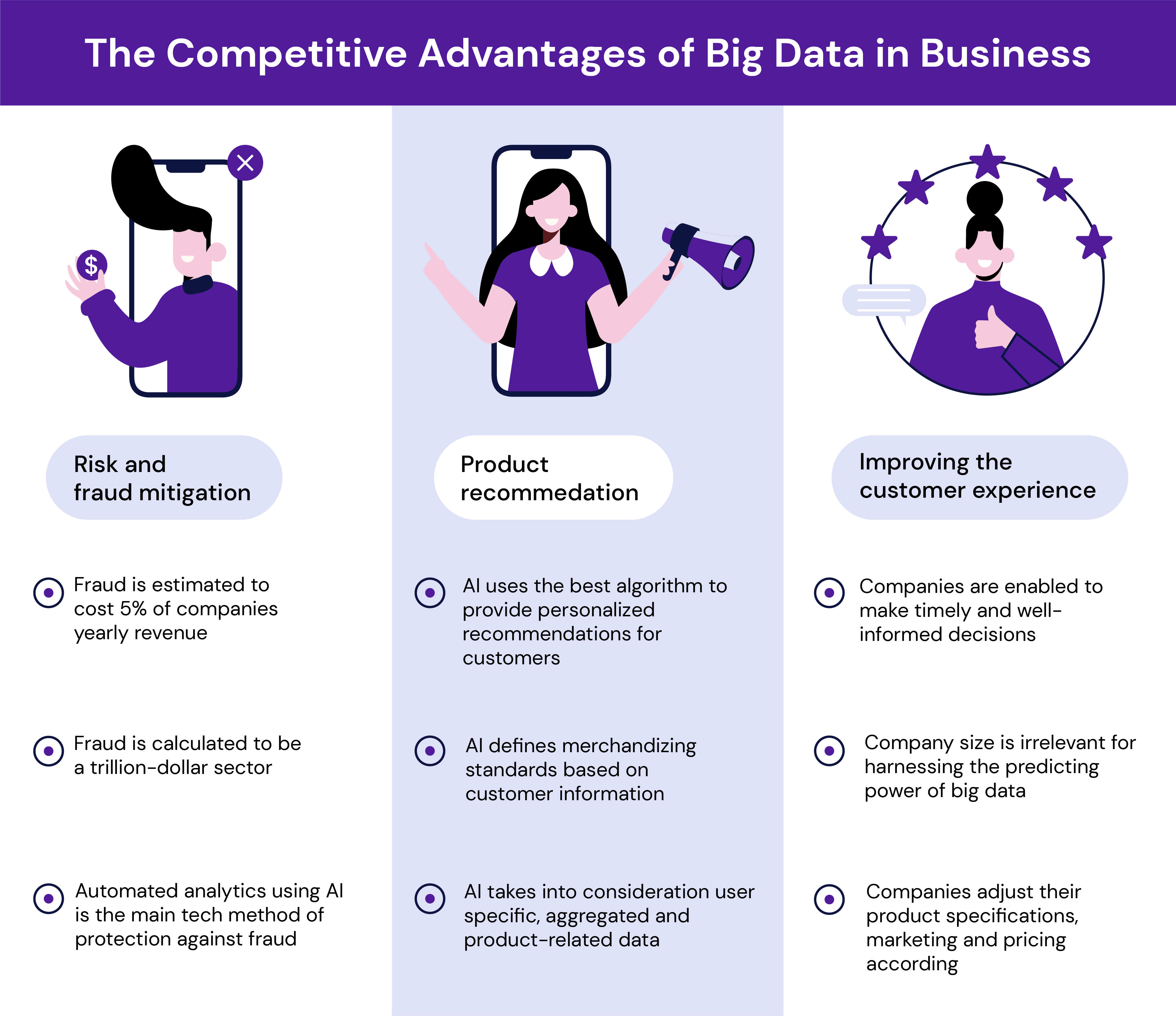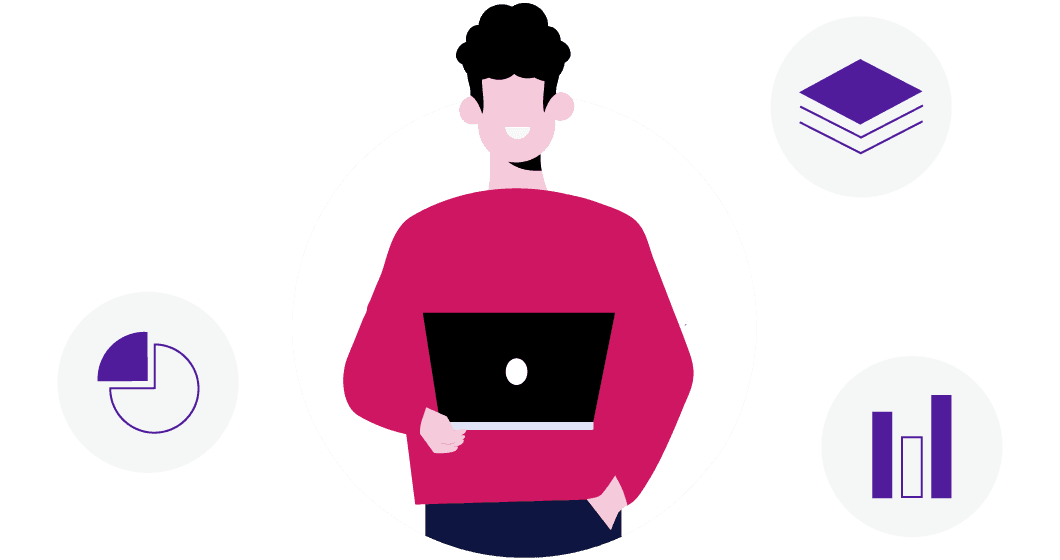Table of content
From Big Data to Big Impact: A General Guide to Big Data Implementation
Did you know that the total amount of data created and consumed globally is expected to surpass 180 zettabytes by 2025? Just in the last year alone, the growth in data volume reached an all-time high as more and more people sought new and convenient ways to earn a living at home or simply to pass the time.
But, what does this mean for you and your business? Keep reading to find out.
The Concept of Big Data
In 2018, the global big data market was valued at 168.8 billion US dollars with a projected growth of 274.3 billion US dollars by 2022 and a five-year compound annual growth rate (CAGR) of 13.2 percent (Mlitz, 2021). So, big data is a big deal! But, what exactly is big data?
Simply put, Big Data refers to sets of data that have been compiled from multiple sources and are far too enormous and elaborate for traditional data processing systems to handle efficiently. And, unlike ordinary data, these sets of data grow continuously at an exponential rate.
Some common examples of big data are:
1. Social networking data: Facebook, for example, generates more than 500 terabytes of data daily. This set of data includes structured data such as names, addresses, and comments, and unstructured data such as pictures, videos, and audio files.
2. Machine-generated data: An aircraft in flight, for example, generates over ten terabytes of data within half an hour. This set of data includes information from various sensors such as altitude, heading, weather information, fuel consumption, GPS, timing, and landing information.
3. Financial data: The New York Stock Exchange (NYSE) market, for example, produces more than one terabyte of data every day. This set of real-time data includes share rates, opening and closing, high and low indexes, and it continuously increases or decreases depending on the state of global markets.

The Competitive Advantages of Big Data in Business
Contrary to popular belief, the importance of Big Data has less to do with the amount of data collected and more to do with the uses of the data. Here is where Big Data analytics come into play.
Big data analytics is a process that is used to uncover valuable insights from large amounts of data. These insights include current trends in the market, hidden patterns and correlations, and preferences of a specific demographic, for example, women under 30. Plus, thanks to the latest advancements in business intelligence (BI) technologies, this complex process of data analysis can now be executed with speed, precision, and efficiency.
But, the advantages of big data do not stop there. With the use of business intelligence, there are many other benefits to explore. For example:

1. Risk and Fraud Mitigation
According to the Association of Certified Fraud Executives (ACFE), fraud costs businesses approximately 5% of their revenue every year. And, due to the current trend of e-commerce that was catalyzed by the COVID-19 pandemic, fraud is now reportedly a trillion-dollar industry, and the use of traditional fraud management systems is ineffective against this advanced threat. Fortunately, recent developments in business intelligence can provide businesses with an effective fraud detection system against known and unknown forms of fraudulent activity.
2. Product Recommendations
Businesses often make the most significant investments in their products. These investments, however, do not always pay off. Thankfully, this is not the case with investments in big data. Effective analysis of data from third-party outlets where consumers advertise their feelings about various products can provide valuable insights into consumer needs. This information can give businesses a competitive edge when utilized correctly and efficiently.
3. Improving the Customer Experience
Advanced and intelligent methods can improve competition and efficiency based on consumer needs and client preferences and optimize a company’s personnel. The optimal usage of data and observations will then contribute to frequent improvements in output due to the end-to-end storage and forecasting of leading operational metrics.
In summary, big data helps businesses to make immediate and informed decisions about their finances, goals, and outcomes as well as their image and branding. The good news is that these and other competitive advantages are available to any enterprise, big or small, that knows how to utilize big data effectively. Therefore, we encourage all businesses to hop on the big data train.
The Strategic Implementation of Big Data in Organizations
Now that you are on board the big data train, you need to ask yourself the important questions: “Where do I want to go?” and “What route should I take?” Without definite answers to these two basic questions, you will be stalled and the advantages of big data will remain out of your reach.
What you need to successfully begin your venture into the world of big data is an effective big data strategy that should be firmly integrated into your business strategy. Ideally, it should provide a clear outline of the intended use of big data in your company and, more so, the type of big data that is best suited for those goals.
So, in this part of the article, you will learn 7 simple steps for implementing a big data strategy in your organization.

Step 1: Outline the Intended Use of the Data
Big Data has no value if it has no purpose. Therefore, it is important to outline the intentions for big data in your business at the beginning of the planning stage. These goals for big data should be linked to the company’s main goals and priorities. They also must be able to manifest real and observable results that enable informed decision-making and boost the company’s overall performance directly or indirectly.
For a more detailed guide on how to formulate effective uses for big data, check out this Data Use Case Template by Bernard Marr, a bestselling author, and Big Data guru, who may be of some assistance.
Step 2: Select the Right Data for the Job
With big data, companies are likely to have some difficulty choosing the type of data that is best suited for achieving their goals. This role should therefore be given to a qualified and well-trained team of professionals who specializes in big data. For example, data analysts, data engineers, and data scientists.
After deciding what type of big data is needed, the company can go ahead and acquire the data. This process usually occurs in two steps:
1. Ingestion: This involves collecting data from different outlets and transferring them to a single network. Data may be in various formats, including CRM, point of sale, and call reports organized data, whereas unstructured data include documents, files, e-mails, images, commentary, and social networking feeds.
2. Transformation: This involves refining and structuring the data to enable researchers to use the best data science methods for more study after acquiring data.
Step 3: Employ Appropriate Big Data Tools
Choosing the best software or tools to accommodate Big Data techniques and technology is necessary for a successful implementation. For example, Apache Hadoop is a common platform for the efficient treatment of petabytes of unordered and organized data, and other providers such as Storm and Qubole are known for processing vast amounts of data in only a few seconds on the sector. In addition, programming techniques like R, Python, SAS, and Tableau can be used by companies to review data and obtain practical insights.
Step 4: Identify a Method of Analysis
Companies must identify a method and empirical models for determining key performance indicators. For data-driven optimization, for instance, reliable statistical/machine learning models are needed. Also, forecasts of consumers’ online purchasing practices need a model that is capable of solving broader optimization problems between roles and product lines. However, it should be noted that the analysis model requires filtered data so, there is some level of uncertainty with this method.
Step 5: Integrate With the Cloud Model
The theoretical procedures for the flow of data – from pre-positioning to predictive modeling to implementation and overview – within an organization has to be aligned with data security-backed public and private cloud provisions. The benefit of cloud-based models is that they can be extended according to market requirements.
Step 6: Execute a Prototype Project
The purpose of a prototype project is to test the big data strategy before the company commits fully to it. This way companies are able to detect any flaw in the strategy and decide the best way forward, that is, whether to fix the flaw or create an entirely new strategy. Additionally, this test enables companies to uncover unforeseen findings.
When creating a prototype project, consider the following:
a. The project should have a data confidentiality and protection policy.
b. Backup measures should be provided
c. Qualitative or quantitative measurements of ROI should be captured.
Step 7: Use Insights to Make Informed Decisions
The ecosystem for big data needs careful experimentation. Businesses must incorporate analytics into strategic decision-making to achieve a competitive edge. The exponential development of extensive data makes the capacity to model and predict data a norm. These results are part of everyday activities which enable companies to remain on the development track.
Successful Cases of Big Data Implementation
In the last two years, 90% of the world’s data was created. Today, businesses now spend over $180 billion a year on big data analysis. Here is a brief analysis of three of the most progressive companies that are continuously benefitting from their investments in big data.

1. Amazon
Amazon is a company that continuously grows its client base by introducing new products and providing services that cater to almost every consumer need you can think of. Most importantly, Amazon assesses its customers’ satisfaction by allowing them to rate and review these products and services. This feature generates tons of data from different consumers all around the world and analysis of this data provides the company with useful insights about their customers as well as their products. Amazon then uses this information to further boost its revenue. And, proof that this big data technique works is in Amazon’s financial reports which indicated that the business acquired $125.6 billion in sales during the fourth quarter of 2020.
2. Marriott International
Marriott International, unlike many other businesses that struggle to provide customers with highly tailored experiences, understands that advanced data analytics is essential for gaining and maintaining competitive advantages. In fact, Marriott is known to use the vast volumes of data that are generated in the travel and hospitality industry to provide innovative ways to keep its business strategy in line with its top priorities. For example:
a. Dynamic Pricing: This requires precise, real-time data from a wide range of sources like local and global financial indicators, events, and weather reports, as well as crucial metrics like estimated average rate, termination and availability, variable cost per unit, reservation behavior, average room rates, and gross profitability per available room.
b. Revenue Management: A small percentage of Marriott’s revenue is invested into its Revenue Optimization System (ROS) which combines data from various sources and provides optimum pricing based on real-time evaluation and market segmentation. This enables Marriott to maximize profit while maintaining adequate staffing.
c. Guest Service Robots: Each room in Marriott’s hotels will soon be outfitted with Amazon Echo devices using ‘Alexa for Hospitality which will enable customers to access restaurant information, order services, listen to audio, read books, play songs, and manage smart home devices like lighting, thermostat, and TV.
d. Facial Recognition Check-In: Marriott is experimenting with face recognition which will allow customers to check in through a computer terminal and avoid waiting in queues at the desk. This aligns with the company’s main goal to give its clients the most pleasant and frictionless experience.
These various approaches to big data help Marriott to stay ahead of other competing brands by enabling them to provide a better guest experience, better staff management, more effective inventory management, and more simplified operations. At the end of 2020, Marriott’s total liquidity was worth approximately $4.4 billion. Plus, the company had roughly $0.8 billion inaccessible cash and $3.6 billion in unused borrowing capacity under its revolving credit facility. This is further proof that big data works!
3. Netflix
Netflix is a production company that is best known for its streaming service which gives users access to thousands of movies, television shows, documentaries, and more. This streaming platform currently has 151 million members who continuously generate data that are analyzed by the company to gain insight into these consumers’ preferences. For example, Netflix knows when and where a program was viewed, the device used to view the program, whether or not the viewer watched the program from beginning to end, the number of times the viewer watched the program as well as the number of searches the viewer made, and all the programs that were searched for. Netflix also allows each user to provide feedback in the form of comments and numerical ratings. All of this information is compiled into user profiles which are used along with a recommendation algorithm to customize each user’s homepage with suggested content. And, according to the company, over 75% of user activity is based on these personalized suggestions. With this approach to big data, Netflix has seen a steady increase in its global subscriber, hitting a record of 204 million members in the fourth quarter of 2020. Plus, according to a statistical report, Netflix generated a total net income of over 2.7 billion dollars in that same quarter. And, there is no doubt that Netflix's success is largely due to its clever use of big data.
Conclusion
In the last two years, 90% of the world’s data has been created, and businesses spend more than $180 billion a year on big data analysis. In short, we can say that big data applies to each business that is significantly attached to advanced technology. Businesses that require optimization in growth, product, and revenue must follow big data implementation in their organizations. Moreover, the finance and commerce sector is also getting valuable output from Big Data. In the future, businesses will strictly adopt this technique before making any decisions to consume their resources in the right direction. Thus, business intelligence can improve the quantity and quality of production by analyzing the data and making accurate decisions accordingly.
